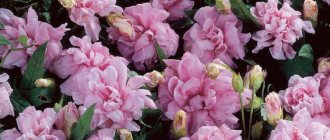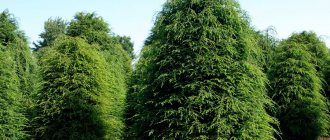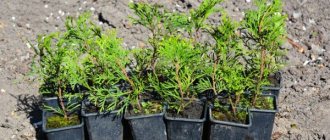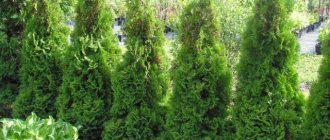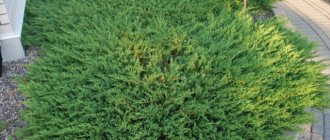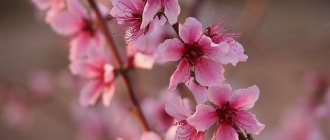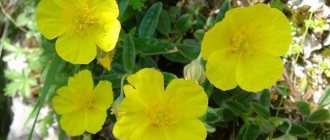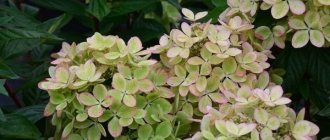Of course, among perennial plants, gardeners prefer large ones that can decorate the garden with luxurious bushes for many years and will bloom tirelessly and for a long time, creating beautiful compositions, but in the class of garden perennial crops there is a plant with a special position - this is the unsurpassed sanguinaria.
It is modest, miniature, blooms for only a few weeks, and plays the role of an accent in shady areas. This garden perennial is one of the most exclusive. Sanguinaria is beautiful, and among shade-loving plants it has no equal.
Description of the Sanguinaria
Sanguinaria canadensis planting and care in open ground photo of flowers
In its majestic beauty, sanguinaria can only be compared with water lilies. Sanguinaria inflorescences really look like these water nymphs; from a distance it may seem as if the pond queens miraculously found themselves in a garden bed. The similarity is manifested only by the shape of the flower. Otherwise, sanguinaria are of a completely different nature - unpretentious, hardy, and do not need much soil moisture.
Bloodroot - mystical name
Sanguinaria bloodroot photo
North America is considered the birthplace of sanguinaria. The plant secretes a reddish-orange sap whenever it is damaged, which is why it received its second name – “bloody root”. The Indians used this juice to paint their faces.
- The plant has a powerful, horizontal rhizome, branches like spruce branches, reaches 2 cm in thickness.
- Internodes live for 3-4 years, but sanguinaria is capable of self-renewal: it lays buds on young branches. The roots grow quickly, layering each other in layers, forming a complex underground root system.
- Often the buds of the plant come to the surface, and young shoots grow into the ground. The roots of the plant have an intense red color, which fully justifies the bloody name.
The height of the plant does not exceed 15 cm, which allows you to create attractive, well-growing baby bushes on the site. It develops and expands quickly, creating clearings.
The leaves are just as beautiful and show themselves in an unusual way. During the flowering period, they are almost invisible: they wrap around the peduncles, highlighting the flowering in all its glory. After a couple of weeks they gradually open up. The leaves are heart-shaped, reach a length of 30 cm, are dense in texture, covered with raised veins on the underside, and the edges are decorated with teeth.
A significant drawback of sanguinaria is that it does not last long. It fades quickly, and the leaves fade in hot sunny weather, leaving bald spots instead of bushes.
Bloom
From each bud only one peduncle appears and at first only one leaf enveloping it. The diameter of the flower reaches 5 cm. They are beautiful and will compete with peonies. Flowers can be simple or double, and they are created by nature and not bred by breeders. Simple flowers are similar to daisies: they are flat, the petals are oval, and the core is yellow. In double species, the flower is hemispherical, the petals are oval, the diameter is 7-8 cm. What makes the flowering fabulous and unusual is its color - snow-white, shining with mother-of-pearl, in the shade it looks especially bright, as if glowing from within.
Sanguinaria blooms for only a couple of weeks. But even this short period is enough for the effect to be powerful. Flowering begins in early spring, as soon as the snow melts and the soil warms up. The flowering period depends on weather conditions: in a cool spring it can bloom for about a month, and in a sunny and warm spring it can bloom for only 2 weeks.
Indications for use
- Pain in the head, as if from sunstroke. Pulsation and pain during the daytime, until the evening. Pressing pain in the back of the head, spreading to the temples and the area at eye level. The duration of this feeling is from five days. Intensifies with sudden movements and changes in body position. The pain also increases after eating spicy or fatty foods.
- Otitis, accompanied by burning and congestion in the ears.
- Rhinitis, which is characterized by copious discharge. In this case, the mucous membrane is irritated, suppuration is possible, which causes loss of smell, obsessive foreign aromas. Rhinitis begins due to allergic reactions to pollen and flowering. If a person is very sensitive, then fainting is possible.
- Severe pharyngitis, in which you feel heat in the throat, dry mouth, feel thirsty, and hyperemia of the mucous membrane occurs. Upon careful examination of the mucous membrane, its changes are noticeable. Discharge at an advanced stage in the form of blood mixed with pus. Right-sided lesion of the tonsil.
- Dry, intermittent cough, tracheitis manifests itself. Coughing attacks worsen at night and when lying down. This occurs due to tingling and tickling in the throat.
- Cough without phlegm (bronchitis). If you take a sitting position, you can cough; a horizontal position is accompanied by a worsening of the condition.
- The onset of pneumonia, which causes stabbing pain in the chest. Cough with purulent or bloody impurities. Jaundice manifests itself in advanced stages and localization of the disease in the lower lobes of the lungs.
- Hepatitis pain extending to the right forearm. Identified by the presence of watery stools.
- Pain in arthritis, localized in the joints.
- Damage to the cervical spine due to osteochondrosis.
- Bleeding from the uterus.
- Increased chance of miscarriage.
- Erosion of the uterine cervix.
- The period of menopause, when blood pressure rises.
- A rash on the face, most often dermatitis, which occurs in young women due to disruptions in the menstrual cycle.
- Purulent acne on the skin and malignant ulcers.
Important! The use of a drug that contains Sanguinaria is prohibited during pregnancy, children under 16 years of age, and people with individual intolerance.
Conditions for growing sanguinaria
Selecting a location
Most believe that sanguinaria is shade-loving. It would be more accurate to say that this baby is universal and adapts to different lighting conditions. Grows equally well in the shade, under dense trees and in bright sun. It will not suffer from a lack or excess of light. However, keep in mind that the better the lighting, the more abundant the watering should be.
Priming
Pay special attention to the soil. High-quality garden soil is suitable: loose, water- and breathable. Compacted, neglected soils will destroy the baby. It should also not be planted in damp areas or where there is a risk of excess moisture.
Sanguinaria care
Sanguinaria flowers how to care photo
When grown in shade or partial shade, this flower will become an unpretentious perennial, because it will only need fertilizing for beautiful flowering perennial plants, which is applied once in early spring.
Watering and fertilizing
A sunny area will need a little more attention: compensate for bright lighting with regular watering, do not let the soil overheat and avoid prolonged drought. At the beginning of spring, you also need to apply a complex of mineral fertilizers.
Wintering
Shelter for the winter is not required, because sanguinaria is frost-resistant and will survive the most unpredictable winters, even in harsh regions.
Who is the remedy indicated for, psyche
Sanguinaria canadensis is used for attacks of anger and irritability, which manifest themselves in relatively calm people.
With a pronounced surge of negative emotions, causing dizziness and vomiting.
It has an effect on poor memory, stupor, and slowness.
Insomnia due to headaches and frequent bad thoughts. Alcoholism and other addictions that stupefy the head.
Sanguinaria is indicated for use by people who experience occipital pain that rises through the back of the head and extends to the forehead. Pain can act as a separate symptom or be present against the background of any disease. In the homeopathic literature, cases of such pain in women during menopause and so-called “hot flashes” have been recorded.
Despite the fact that the plant is poisonous, with the correct dosage calculated by a specialist, the homeopathic medicine cures many diseases and also helps restore hormonal levels in women. Source: flick (Eugene Evehealth).
Reproduction of sanguinaria by dividing the bush
How to divide a sanguinaria bush photo
- As soon as all the leaves on the beauty have withered (late August-early September), the root can be divided.
- Do not make large divisions; it is enough to separate a piece of rhizome with at least one bud on it.
- Be careful not to tear off or injure the roots on the lower part of the rhizome.
- Plant the delenka according to the general planting rule, as described above.
Growing sanguinaria from seeds
Seeds of Sanguinaria canadensis photo
Sowing seeds has its drawbacks - such plants will bloom 3-4 years after planting in the ground. Seeds must be stratified for three months (place the seeds in a bag, mix with damp soil, and put in the refrigerator).
- It is best to sow in large containers, maintaining a decent distance for comfortable development of seedlings (5-6 cm).
- Use a loose, light substrate.
- Planting depth 0.5-1 cm.
- Spray containers with crops from a spray bottle, cover with film and place in a warm, bright place.
Sanguinaria seeds planting seedlings photo
- Plants are picked as early as possible after the formation of the second true leaf, using the transshipment method with complete preservation of the earthen coma around the roots.
- It is better to replant them in peat pots, so that later you can simply plant them in the ground and not disturb the roots of the plants.
- When growing seedlings, it is important to avoid waterlogging or severe drought. At the beginning of summer it can be planted in open ground.
Compatibility
Sanguinaria (Canadian Sanguinaria) – antidote for Opium, Cicuta.
Exact compatibility with scarlet fever - Belladonna.
Scientists compare class relatives: Chelidonium, Opium.
Read also: Pigeon chicks and city dwellers
If rheumatism is severe - Magnesia Carbonic.
Headache starting from the back of the head and passing to the right eye (above it) - Spigelia, Sepia - above both eyes;
Headache with anterior localization - Gelsemium, Lachesis, posterior localization - Anacardium, Bryonia,
Chininum sulphuricum, Naja, Nux vomica.
Similar medicines: Belladonna, Veratrum vir, Iris, Melilotus, Phosphorus.
Sanguinaria in landscape design
Sanguinaria is actively used as:
- festive, exclusive accent of the front garden
- highlighting plant at the base of shrubs and trees
- a luminous spot in the shade of the garden
- a solemn and elegant decoration of a flower bed, one of the first spring flowers
- decoration of rocky areas
To cover fading leaves and hide heathland in summer, plant ferns nearby. In spring it grows well with tulips, daffodils, and scylla.
Types of sanguinaria with photos and names
Sanguinaria canadensis Sanguinaria Canadensis
Sanguinaria Canadian Sanguinaria Canadensis photo
Most popular. It has carved leaves divided into 3-9 lobes. The leaf width reaches 15 cm. The green leaf plate is covered with rays of yellowish veins. The petiole is short, reddish. In the first thawed patches, white flowers with a pinkish tint appear. The diameter is 7-7.5 cm, eight oval petals envelop a light yellow core. Flowering lasts approximately 3 weeks, foliage survives until mid-July.
Application
For homeopathic purposes, the plant acts as an antispasmodic. It has an astringent, antibronchial, antibacterial and antimenopausal effect on the inflamed human body.
Sanguinaria canadensis is often found in medicinal products that are intended to treat inflammation in the joints, and is also part of remedies that relieve:
Homeopathic medicines containing plant extract prevent or relieve:
